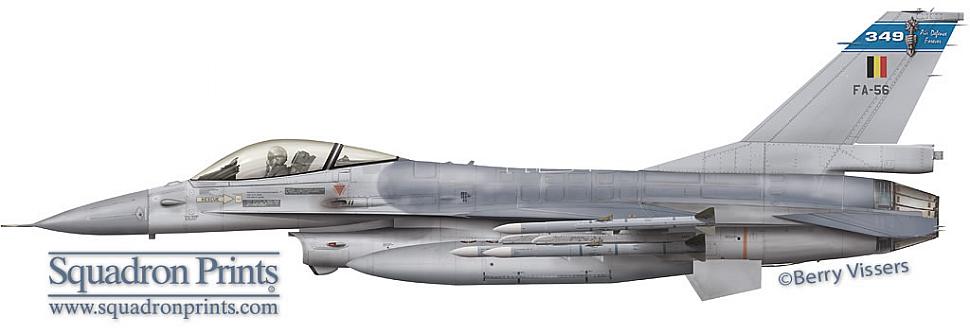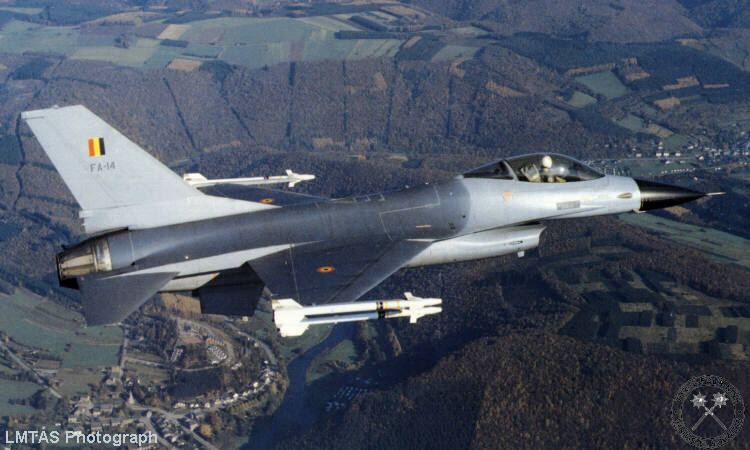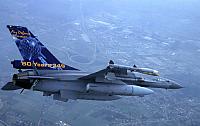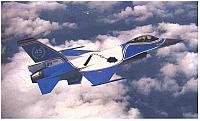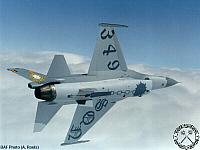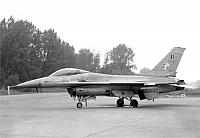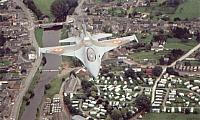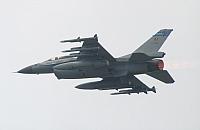 |
349th squadron ( BAF)" Mace" |
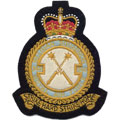 |
349 sqn " Mace" ( BAF) | |||
| Status: |
Active
|
|||
| Version: | F-16A/B block 20 MLU | |||
| Role: | Multirole, Air Defense | |||
| Tailband: | N/A | |||
| Motto: | Strike Hard - Strike Home | |||
| Badge: | Two crossed maces with the motto at the bottom and the British crown on top. | |||
F-16 History
F-16 operations started in 349 squadron on January 16th, 1979 when the first F-16B (#FB-01) was delivered to the Belgian Air Force making it the first F-16 squadron for the Belgians. Initial training on the type was conducted within 349 squadron. A dedicated training squadron was only established a few years later. By May of 1980, 349 squadron had reached IOC and was the first European F-16 unit to be commissioned for NATO duty.
349 squadron has been a part of the 1st Fighter Wing (Wing Jacht Alle Weer/Wing de Chasse) based at Beauvechain AB since 1949. In 1996 however, a major reorganisation of the Belgian armed forces decided upon the transferral of 349 squadron and the OCU to the 10th Wing at Kleine Brogel AB where they joined 23 and 31 squadrons. The 1st Wing was to be disbanded and reactivated as a training squadron, with Beauvechain AB becoming the home of the entire Belgian Air Force training fleet. Instead of having 18 F-16s at their disposal, all BAF squadrons were reduced to 12 aircraft.
Although transferred to the 10th Wing (which used to be a tactical wing), the responsibilities of 349 squadron remained the same. This being 24 hour coverage of Belgian air space with a QRA unit available at all times. This being equipped with two F-16s being ready to intercept any incoming thread within a 15 minute timeframe.
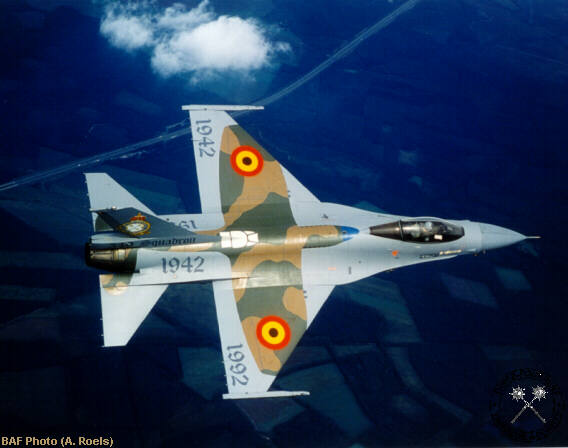
With the limited availability of fighters within the Belgian Air Force, it became apparent that all F-16s should be used in a swing-role concept. During the following years, 349 squadron was thus also converted from a pure intercepting squadron to a multi-role squadron also capable of performing A/G mission when it was required. Specially with the introduction of the MLU version of the F-16 in late 1998 to early 1999, the capabilities of the squadron in the different domains grew drastically.
In 2002 the last reorganisation took place. Because of the fact that all squadrons had a multi-role task at that time, it proved more efficient to have 18 aircraft in every squadron. With the disbandment of 23 squadron within the 10th Wing, 349 squadron received half of its 12 airframes strong fleet, thus increasing the squadrons strength back to 18 F-16s.
Unfortunately, the increase in aircraft made available was quickly changed when in late 2003 the Belgian government announced a further reduction of the F-16 fleet as part of a cost reducing effort for the armed forces. This will mean that 349 squadron will loose 1/3rd of their F-16s again and will keep 12 planes operational in 2015.
Aircraft Markings History
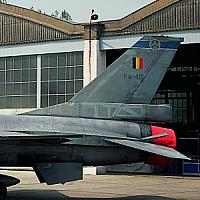
A blue tailband with the squadrons logo adorned the F-16s in this timeframe.
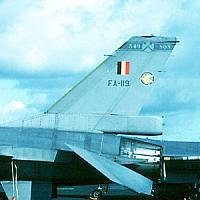
The tailband was retained but executed in a toned-down format with '349 sqn' titles added on each end of the logo. The logo of the 1st Wing was also added on the rudder.

The tailband was kept but executed in a gray format and placed lower on the tail. The Belgian flag was moved from the tail center to the top of the rudder with its place being taken by the 'BL' marking of Kleine Brogel AB. This was only a temporary marking that wasn't accepted by the Air Force staff.

All squadron logos of the Belgian F-16s have been removed after the MLU conversion.
Unit History
- 1942: Activation of the squadron in Ikeja (Nigeria)
- 1942: P-40 'Tomahawk I'
- 1943: 'Spitfire' Mk. VA (RAF Wittering)
- 1943: 'Spitfire' Mk. LF VB (RAF Southend)
- 1943: 'Spitfire' Mk. VC
- 1944: 'Spitfire' Mk. LF IXE (part of 135 Wing (RAF), RAF Selsey)
- 1945: 'Tempest' Mk. V
- 1945: 'Spitfire' Mk. IXB (part of 132 Wing (RAF))
- 1945: 'Spitfire' Mk. XVI (part of 123 Wing (RAF), Wunstorf [Germ.])
- 1945: 'Spitfire' Mk. XVI (part of 135 Wing (RAF), Fassberg [Germ.])
- 1946: 'Spitfire' Mk. XVI (part of 160 Wing, Fassberg [Germ.])
- 1946: 'Spitfire' Mk. XVI (part of A Wing, Beauvechain)
- 1947: 'Spitfire' Mk. XIV (part of 160 Wing)
- 1948: 'Spitfire' Mk. XIV (part of 1 Wing)
- 1949: 'Meteor' F. Mk. 4
- 1953: 'Meteor' F. Mk. 8
- 1957: 'Hunter' Mk. 4
- 1958: CF-100 Mk. 5 'Canuck'
- 1963: F-104G 'Starfighter'
- 1979: F-16A 'Fighting Falcon'
- 1996: F-16A 'Fighting Falcon' (part of 10 Wing, Kleine-Brogel)
- 1998: F-16AM 'Fighting Falcon'
Deployments
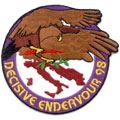 |
' Decisive Endeavour' |
| Villafranca AB, Italy (start operation to December of 1996) | |
| From the start of the Belgian Air Force F-16 operations in former Yugoslavia till December of 1996 it was part of 'Decisive Endeavour'. This was an operation in support of the UN-led IFOR troops stationed in Bosnia-Herzegovina. | |
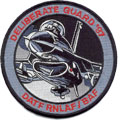 |
' Deliberate Guard' |
| Villafrance AB, Italy (December of 1996 to June 20th, 1998) | |
| When the UN forces in Bosnia-Herzegovina changed their mandate resulting in a name change from IFOR to SFOR, also the air operations were given another name. Ultimately, 'Deliberate Guard' formed the air asset for the SFOR troops. | |
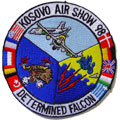 |
' Determined Falcon' |
| Villafranca AB, Italy (June 15th, 1998 to June 16th, 1998) | |
| Operation 'Determined Falcon' was a one-day operation to show force over Kosovo and Albania. NATO fighters patrolled this airspace coming only within 10nm of Serbian territory. This operation was meant as a warning to Serbian politicians to stop the bloodshed in this Yugoslavian province. | |
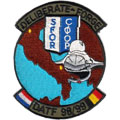 |
' Deliberate Forge' |
| Amendola AB, Italy (June 20th, 1998 to end operation) | |
| Operation 'Deliberate Forge' was the successor of operation 'Deliberate Guard'. When the SFOR troops were reorganised into a smaller force, the covering air campaign also received a new name. This operation continued until the end of Belgian Air Force operations in Yugoslavia, which ended in the summer of 2001. | |
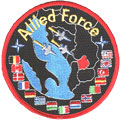 |
' Allied Force' |
| Amendola AB, Italy (March 23rd, 1999 to June 10th, 1999) | |
| Operation 'Allied Force' was the codename for the almost three month long air strikes against Serbia. 349 sqn was the first Belgian sqn to drop a GBU-12 bomb during this campaign, resulting in the first offensive operation of the Belgian Air Force since the end of WWII. | |
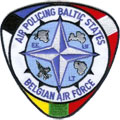 |
' Air Policing Baltic States' |
| Siauliai AB, Lithuania (March 30th, 2004 to June 30th, 2004) | |
| This operation started when Lithuania, Estonia and Latvia joined NATO. These countries don't have fighters themselves and rely upon NATO for their air coverage. In a three-month rotation Belgian F-16s will patrol the skies over the Baltic States. | |
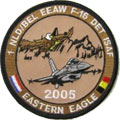 |
' ISAF - Eastern Eagle' |
| Kabul AB, Afghanistan (July 14th, 2005 to January 14th, 2006) | |
| As a reinforcement for the ISAF air asset, the Belgian government decided to station 4 F-16s at Kabul AB together with the same number of Dutch aircraft to secure the parliamentary elections of September 2005. The initial four-month deployment was eventually extended to 6 months. | |
 |
' Air Policing Baltic States' |
| Siauliai AB, Lithuania (December 1st, 2006 to March 31st, 2007) | |
| This is the second deployment of the Belgian Air Force to the three Baltic states (Lithuania, Estonia and Latvia). This time a four-month rotation will see the Belgian F-16s patrol the skies over the Baltic States. | |
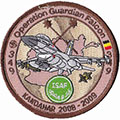 |
' ISAF - Guardian Falcon' |
| Kandahar AB, Afghanistan (January 1st, 2009 to August 31st, 2009) | |
| In the summer of 2008 the Belgian government decided to step up and Join the NATO effort in Afghanistan with F-16 fighters. A total of 4 fighters were dispatched who strenghtened the Dutch contingent. The Belgian operation was called Guardian Falcon. The first rotation was done by the 2nd Wing. | |
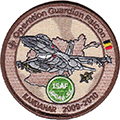 |
' ISAF - Guardian Falcon' |
| Kandahar AB, Afghanistan (May 1st, 2010 to December 31st, 2010) | |
| This marked the second deployment of the squadron in the Guardian Falcon rotational deployments. By this time the detachment had risen to 6 aircraft being deployed. | |
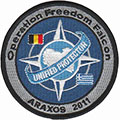 |
' Odyssey Dawn / Unified Protector' |
| Araxos AB, Greece (March 23rd, 2011 to October 31st, 2011) | |
| Originally the squadron was at Araxos for a training session with the Hellenic Air Force. This training deployment soon evolved in a real air operation with the squadron being one of the first over Libya during this operation. | |
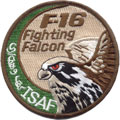 |
' ISAF - Guardian Falcon' |
| Kandahar AB, Afghanistan (September 1st, 2011 to December 31st, 2011) | |
| OGF X was a shorter deployment of the squadron. This was due to the ongoing operation in Libya. | |
 |
' ISAF - Guardian Falcon' |
| Kandahar AB, Afghanistan (May 1st, 2012 to December 31st, 2012) | |
| Not long after the Libyan operation the squadron was tasked with another deployment into Afghanistan. | |
 |
' ISAF - Guardian Falcon' |
| Kandahar AB, Afghanistan (September 1st, 2013 to April 30th, 2014) | |
| Another rotation into Afghanistan. These missions are always conducted together with the sister squadron, the 31st. | |
 |
' Air Policing Baltic States' |
| Siauliai AB, Lithuania (September 3rd, 2013 to January 2nd, 2014) | |
| Together with the deployment in Afghanistan the squadron was tasked with yet another mission to protect the Baltic States. | |
 |
' ISAF - Guardian Falcon' |
| Kandahar AB, Afghanistan (September 1st, 2014 to September 27th, 2014) | |
| This marked the final rotation of the squadron into Afghanistan. It was originally planned to end this mission at the end of October, but in the end the F-16s were withdrawn in late September as tensions in the Middle East rose and another deployment was more imminent than this one. This mission marked the end of 6 years of Belgian F-16 presence in Afghanistan. | |
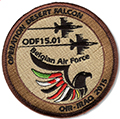 |
' OIR - Desert Falcon' |
| Al Azraq AB, Jordan (September 26th, 2014 to June 30th, 2015) | |
| The first rotation to fight against DAESH - IS. This rotation was executed with 6 F-16s coming from all 4 Belgian squadrons changing pilots and ground personnel over the entire deployment period. | |
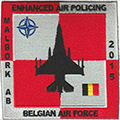 |
' Enhanced Air Policing' |
| Malbork AB, Poland (January 3rd, 2015 to August 31st, 2015) | |
| From 2015 onwards the number of locations for air policjg in Eastern Europe was expanded not only to include the Baltic States. Belgium sent 6 F-16s and a crew of 120 to support this mission. Al 4 squadrons rotated into Poland. |
F-16 Airframe Inventory
- All 349 sqn F-16s in our F-16 Aircraft Database (past and current aircraft)
- Current 349 sqn F-16s in our F-16 Aircraft Database
Photos
The initial conversion of the pilots of the 1st Fighter Wing took place in the F-16 Conversion Flight, under the command of Maj Jef De Heyn who received his F-16 conversion between July and December 1978 at Edwards AFB together with SABCA pilot Maj G. Devolder, they were the first two Belgian pilots qualified on F-16. Four other Belgian pilots had their training at Edwards AFB, Capt Toussaint, Capt Van Beneden, Capt Fransen and Capt Van De Velde.
The first conversion started in July 1979 consisting of seven pilots of the Air Staff at Brussels and Beauvechain, including the 1st Fighter Wing base commander.
The first actual conversion class of six 349 Sqn pilots started on 17 September 1979.
Please use this form to add any list any error or omissions you find in the above text.
Note: your comments will be displayed immediately on this page. If you wish to send a private comment to the webmasters, please use the Contact Us link.

